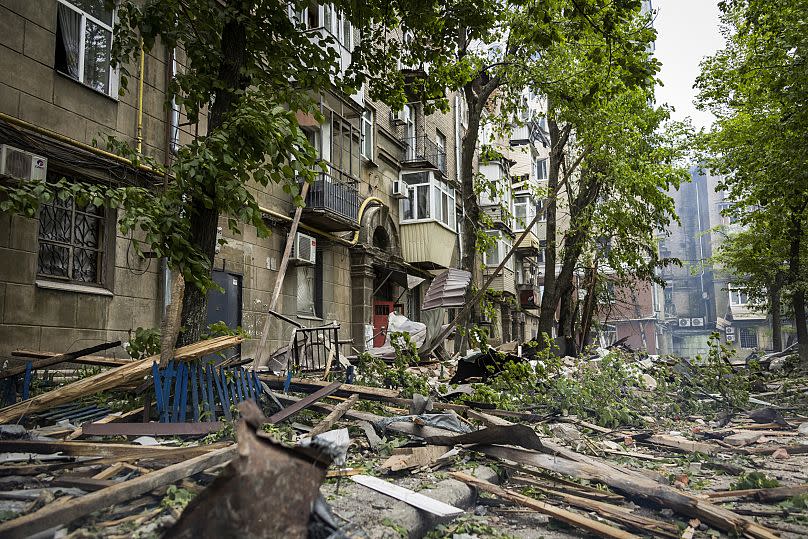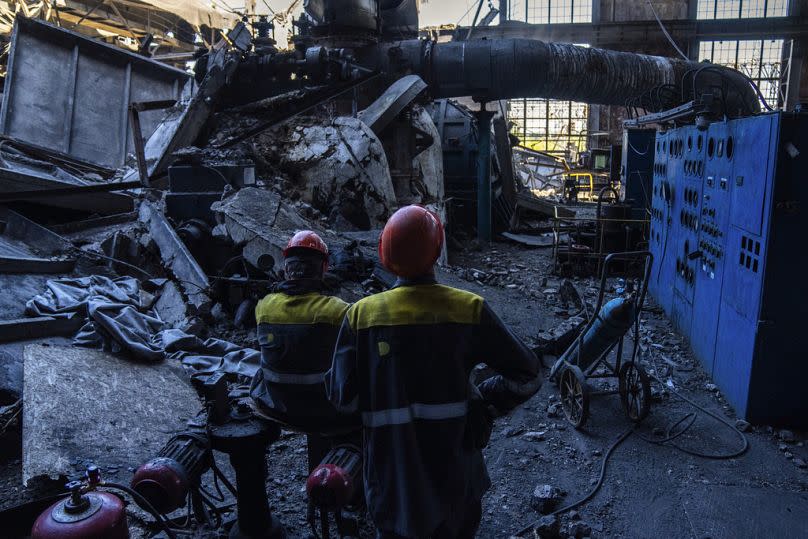The cost of ‘conflict carbon’: Russia could face €30bn climate reparations bill for war in Ukraine

Russia’s war in Ukraine has emitted roughly 175 million tonnes of carbon dioxide in 24 months, according to the most comprehensive such study of any war to date.
This is the equivalent of the annual use of 90 million cars and could cost Russia nearly €30 billion in reparations for the climate damage it has caused.
The report comes from the Initiative on Greenhouse Gas Accounting of War (IGGAW) which has been developing new methodologies to measure this ‘conflict carbon’. The initiative’s series of assessments is the first to map the emissions of any war on such a comprehensive scale.
Where does this ‘conflict carbon’ come from?
A third of emissions come from military activity, particularly the billions of litres of fuel used by Russian vehicles. This is the single greatest source of emissions accounting for around 35 million tonnes of carbon dioxide equivalents.
Jet fuel, bombs and concrete: The 60 million tonnes of carbon generated by Israel’s war on Gaza
UN chief calls on governments to stop fossil fuel ads: Where are they already banned?
Another third comes from the huge quantities of steel and concrete that have been and will be needed for reconstruction.

The final third comes from a variety of sources. Wartime fires have significantly increased in size and intensity since the invasion on both sides of the frontline. Satellite images have revealed that some 27,000 fires have burned nearly a million hectares of land.
Commercial planes have been rerouted due to restrictions and safety concerns clearing 18 million square kilometres of sky over Russia and Ukraine. Diversions between Europe and Asia have added extra fuel use causing net emissions of just over 24 million tonnes.
Energy infrastructure strikes are another source. In the first weeks of the war, Russia carried out major strikes on Ukraine's fossil fuel depots.

But the emissions from this were dwarfed by the destruction of the Nord Stream pipelines. This resulted in a week-long undersea eruption of methane with a climate impact equivalent to as much as 14 million tonnes of carbon dioxide equivalents.
One of the most unusual sources of emissions is sulphur hexafluoride or SF6 which is used to insulate electrical switchgear. It is the single most powerful greenhouse gas with 23,000 times more heating power than carbon dioxide. SF6 has escaped in particularly high amounts - some 40 tonnes equivalent to about a million tonnes of CO2 - due to Russian strikes.
To a lesser extent, the movement of nearly seven million Ukraine refugees and Russian refuseniks has also contributed.

“[The] carbon emissions of this war continue to grow,” says IGGAW lead author, Lennard de Klerk.
This assessment of the climate damages from the war in Ukraine is the fourth since it began with each furthering our understanding of the developing emissions sources.
Total global military spending, for example, reached $2.4 trillion (€2.2 trillion) in 2023, increasing by 6.8 per cent in real terms since 2022. That is the steepest year-on-year increase since 2009 with factors like production of military equipment and long-distance deliveries of heavy arms all contributing to emissions.
“While in the first assessments, the reconstruction represented the biggest share,” de Klerk explains, ”now warfare is about the same as reconstruction with warfare continuing unabated.”
What is the cost of conflict carbon?
Using the latest methodology, researchers have put a cost on each tonne of carbon emitted. New peer-reviewed research published in the journal Nature significantly increased the amount per tonne of emitted CO2 since the last assessment, giving updated figures.
Scientists say Earth is heating at a record rate, but there’s still time to stop crisis accelerating
May breaks global temperature record for 12th month in a row. Will La Nina bring cooler weather?
The IGGAW now estimates that Russia faces a $32 billion (€29.5 billion) bill for climate reparations from the first 24 months of the war.
The Ukrainian government has welcomed the report saying it will contribute to the country’s compensation case against Russia.
“The analysis published today is the most up-to-date and thorough snapshot we have of the climate consequences of Russia’s invasion, helping to lift the fog of war that exists also when it comes to the environmental costs of conflict,” says Ruslan Strilets, Ukraine's minister of environmental protection and natural resources.
“It will be an essential plank in the reparations case we are building against Russia.”

In 2022, a UN General Assembly Resolution called for Russia to compensate Ukraine for the war, with the Council of Europe setting up a registry of damage. The report on climate emissions is set to become a part of this registry.
“Russia is harming Ukraine but also our climate,” de Klerk says, adding that the sizable quantity of this conflict carbon will be felt globally.
“The Russian Federation should be made to pay for this, a debt it owes Ukraine and countries in the global south that will suffer most from climate damage.”
Researchers are developing their methodology from scratch
Data on the carbon emissions of conflict is often scarce. Wartime secrecy, physical dangers and displaced experts make it difficult to put these estimates together. IGGAW is an association of carbon accounting experts, funded by Western governments and foundations, that has been attempting to overcome these hurdles.
A new methodology also needs to be developed to even begin to produce these figures from that data.
Meet the climate catastrophe victim filing a criminal case against the bosses of oil firm Total
‘The sea is sinking the island little by little’: Coastal community evacuated due to sea level rise
“You have to develop it from scratch,” de Klerk says.
“That takes time and you might overlook some sources of emissions. That is why we fine-tune the methodology with each iteration.”
The second obstacle, he adds, is the availability of data. IGGAW's estimate of the emissions from Russia’s war in Ukraine relies heavily on satellite data, governmental information, scientific studies and open-source intelligence, interviews with experts and industry reports, among other information.


